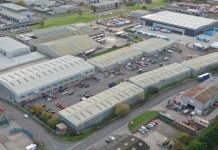Lambert Smith Hampton’s latest South East Office Market report finds that resilient demand and a lack of current and future prime space are creating an unprecedented regional investment opportunity:
Despite geopolitical and economic uncertainty, leasing activity so far in 2025 has been strong. Q1 take-up hit a three-year high of 1.1m, and expectations of circa 900,000 sq ft of additional take-up in Q2 will make for the strongest half-year total since H2 2021 (9% above the long-term average).
The revival partly reflects a resurgence of larger transactions. Q1 saw 14 deals above 20,000 sq ft, compared with six in Q4 2024.
Near-term demand also appears resilient. As of June 2025, active requirements across the region stand at around 2.3 million sq ft, driven by a big uptick in larger corporate requirements over 30,000 sq ft.
Buoyant demand reflects strong appetite for ESG and more concerted efforts to attract staff back to the office. These trends have helped occupancy rates settle towards a new norm, which is encouraging occupiers to finally get on with the business of relocating into the space they need and in turn driving demand for prime spaces, according to LSH.
Occupiers continue to show willingness to pay for the best spaces. High building, fit-out and staff costs have been more than justified through achievements on rents: average prime rents have increased by an average of 25% on previous high watermarks in markets where prime space has been delivered over the past two years. Standout performers include One Station Hill in Reading (up 45% to £56 per sq ft) and the PLANT in Basingstoke (up 36% to £38 per sq ft).
Supply, currently at a 13-year high, is close to peaking. Although 2.4m sq ft of speculative development was under construction at the end of Q1, 81% of this is in Oxford and Cambridge.
Construction activity is extremely limited elsewhere, at only 350,000 sq ft net of pre-lets. Eighteen of the 25 markets currently have no speculative development underway, and the pipeline of anticipated speculative development outside of Oxbridge is at its lowest level in 15 years.
The upcoming supply crunch also reflects a sharp rise in change-of-use activity, which removed around 4m sq ft of floorspace from the South-East’s office stock from Q1 2024 to Q1 2025. This reduced supply, but is also supporting the transition to a leaner, higher quality market.
Prime assets are even more scarce. Prime buildings account for only 10% of the region’s total supply (or 1.5% of total stock), despite accounting for 23% of take-up over the year to Q1 2025.
Prime supply is also unevenly distributed. For 30,000+ sq ft options, 63% of supply is concentrated in just five markets: Hammersmith & Chiswick, Reading, Slough, Oxford and Cambridge. There are nine markets with at least one 30,000+ sq ft requirement, but no current prime availability. These include Maidenhead, where the imbalance is most pronounced (350,000 sq ft of 30,000+ sq ft requirements set against no existing prime supply of that size).
Moreover, the pipeline of prime speculative schemes outside of Oxford and Cambridge is extremely thin. Only six schemes are expected to start on site over the remainder of 2025 (excluding lab-enabled, hybrid space). This reflects lower developer appetite, which remains constrained by high prevailing yields and perceptions of void risk despite the clear success of prime schemes.
Investment-wise, activity is strong but improving investor sentiment is yet to be reflected in volumes. Q1 saw 35 transactions – the most since Q4 2021 and significantly up on the five-year average of 28.
However, volume stood at £259m in Q1, down sharply from £578m in Q4 2024 and the third lowest out-turn across the past five years. Volumes are set to remain unremarkable in Q2, with current stock amounting to c. £500m and roughly half of what it was a year ago. This reflects limited buying opportunity as opposed to a lack of demand.
Office values have undergone a severe correction but stability is returning. Prime yields are holding steady – yields for in-town assets reflecting 15-year income have plateaued at circa 6.5% since late 2023. Meanwhile the secondary market is bottoming out: notional yields for secondary assets are now circa 12.75%, having softened by around 50bps over the year to Q1.
UK institutions have reduced their exposure to UK offices, in turn opening the door to opportunity-seeking private buyers. Private propcos invested £691m into South-East offices in the year to Q1. Meanwhile overseas buying has been subdued, reflecting an absence of North American inflows.
Andrew Hodgkinson, Senior Director at LSH, said: “Despite economic headwinds, and a growing cost burden that reflects business taxes, prime rents and staff overheads, the ‘new normal’ of office occupancy means we’ve seen a growing trend of occupiers understanding they need more prime space for their staff.
“Something of a perfect storm is occurring – occupier demand is improving, but this comes with a critical lack of prime options and a thin pipeline to boot. What this creates is fresh opportunity for those brave enough to capitalise on this shortfall – especially in aspirational locations with infrastructure and affordability advantages but a lack of prime supply, like Maidenhead, Milton Keynes and Guildford.”
Charlie Lake, Executive Director, National Head of Office Investment at LSH, added: “A painful period of price adjustment is finally coming to an end – not only for prime assets, which have been steadier for longer, but also for the secondary market. Confidence is on the rebound, and there is now more comparable evidence to support realistic valuations at a level that can more easily allow for existing assets to be repurposed to the standards that occupiers demand.
“At the same time strong rental growth, together with a limited choice of best-in-class product, is creating an unprecedented window of opportunity in the value-add space. With an increasing depth of core buyers returning to the sector, there is an opportunity to move fast and exploit the development lag we are in– especially since falling interest rates and improving finance costs could contribute towards a degree of yield compression in the second half of the year.”




















